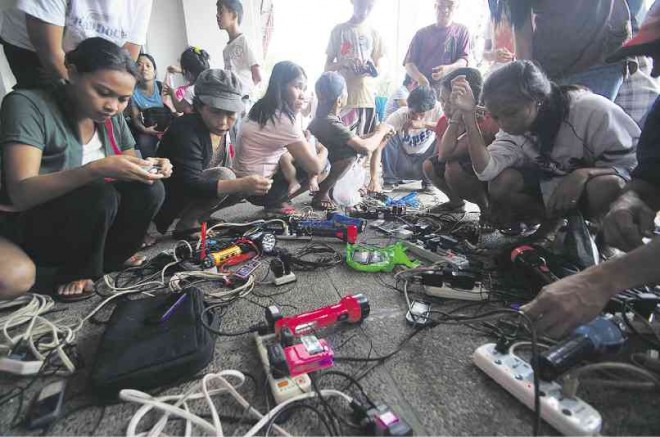Rice, coconut water kept survivors full

CHARGING AREA Hundreds of residents in the capital city of Borongan in Eastern Samar charge their cell phones and flashlights at the provincial capitol. Supertyphoon “Yolanda” toppled telecommunication towers and power transmission lines in the province when it struck on Nov. 8. RICHARD BALONGLONG/INQUIRER NORTHERN LUZON
TACLOBAN CITY—Days before help arrived in Samar and Leyte provinces, victims of Supertyphoon “Yolanda” survived hunger and thirst in various ways. Some subsisted on rice alone while others had coconut water to drink.
Local officials in Samar and Leyte had insisted they did not lack in preparing their constituents for the arrival of Yolanda, but that they did not expect the typhoon’s strength and the devastation it brought to their areas.
Blesilda de Chavez, 32, a mother of three whose home in the coastal town of Guiuan in Eastern Samar was flattened by Yolanda, said her family ate rice for four days until help finally came. “It was lucky enough that my husband bought lots of rice days before,” she said.
De Chavez said she and her husband, a fisherman, used coconut water for drinking and cooking rice when water became scarce.
Many others in Samar and Leyte said they relied on rationing food stocks they had stored after they were virtually cut off from the rest of the country due to toppled telecommunication towers.
Joel Ferrera, 44, of Palo town, Leyte, said the family’s food stocks were good for only a day but he, his wife and their four children managed to stretch the supplies to four days until the government’s first relief items arrived.
Ferrera, head of municipal local government operations of the Department of the Interior and Local Government, went with a a staff member to Tacloban City Hall to apply for an emergency loan from the Government Service Insurance System via the Internet.
Rolito Lace, 31, a structural plumber from San Jose town in Leyte, said he fed his family solely with rice for days, which kept their tummies “full.” Fortunately, his 1-year-old daughter, Lorelyn, was being breast-fed by her mother, Leny.
Victor Salubon, 49, a sanitary inspector in Tanauan town, Leyte, however, said his family became increasingly anxious as the rice and water supplies ran low in their neighborhood before help finally arrived.
Local government leaders in Samar and Leyte disputed reports that they did not prepare enough for the onslaught of the strong typhoon.
Adrian Bernardo, municipal accountant and member of the disaster preparedness council of Guiuan, said in an interview on Sunday that his group was able to evacuate around 10,000 residents before Yolanda struck.
They “forcibly” moved those living near the coastlines to shelters in the town center a day before the typhoon made its first landfall in Samar, he said.
Bernardo said evacuation maps had already been drawn in case of storm surges and tsunamis, and posted these in public places. He claimed that most people had already memorized the map made by local disaster officials two years ago.
Relief packs were stored and distributed to the evacuees inside the shelters.
In Tanauan, Mayor Pel Tecson said in an interview on Saturday that the municipal officials were also able to relocate their constituents a day before Yolanda.
The town had a disaster preparedness plan, Tecson said. The residents were gathered near the municipal hall and enough stocks of food and water were secured, he added.
“We were ready for the wind but we were not ready for the water (storm surge),” Pecson said. Tanauan, a coastal town just outside of Tacloban, was also washed away by the storm surge.
Both Bernardo and Pecson said they did not expect the extent of damage brought by Yolanda. “I’ve never seen anything like it,” Bernardo said.
When Yolanda destroyed telecommunication towers in Samar and Leyte, completely isolating the islands, almost everyone was desperate for contact with the outside world so they could ask for help.
Tecson said he braved the darkness on the second day after Yolanda so he could travel by motorcycle to Daniel Z. Romualdez Airport. He was able to meet with military personnel who were temporarily stationed at the airport to provide help.
Bernardo said the Armed Forces of the Philippines sent soldiers to Guiuan to check the area. “It felt like being found after floating hopelessly and lost at sea for days. We were so relieved to see them. It buoyed our hopes to survive,” he said.
Maj. Angelo Guzman, AFP deputy public affairs officer, said around 100 soldiers from each division or area spared by the typhoon were deployed to Samar and Leyte immediately after Nov. 8. They helped in the distribution of relief items, conducting medical missions and clearing of roads and ports.